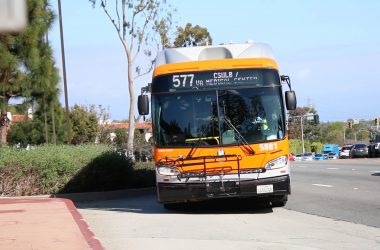Approximately 2,000 fewer prospective first-time and transfer students may be admitted to Cal State Long Beach for the fall 2009 semester compared to last fall.
The enrollment changes were planned to offset taking more students in previous years than the university can fund.
“We’re kind of victims of being the ‘nice guy,'” CSULB Vice Provost David Dowell said.
There were approximately 50,000 CSULB freshman applicants and 1,000 transfer applicants for the fall 2009 semester, according to Dowell. First-time freshmen for the upcoming semester will decrease from 4,600 students to 3,700, and incoming transfer students will change from 3,200 students to 2,200.
“The political and economic costs of not managing this are quite high,” Dowell said. He said if the university does not control enrollment, CSULB would lose about $15 million because the state might “punish us” for trying to enroll more students than the university can afford.
“It’s like, ‘Now that you’ve done it, you obviously don’t need any money for it,'” Dowell said.
There will be a greater decrease in transfer admits than freshmen partly because few transfer students apply for residential housing, Dowell said. The number of freshmen who will be accepted is the minimum to make a profit from residential housing.
“We’ve taken freshmen as low as we can go,” Dowell said. “We can’t really in any way restrict [continuing students].”
According to Dowell, approximately 60 percent of those who live on campus are freshmen, and almost all of the others began as first-time CSULB students.
“If you look back, historically we’ve admitted more transfer students … total in a given year” compared to freshman applicants because transfer applications had been accepted for both fall and spring semesters as opposed to only fall semesters, Dowell said.
The number of transfer students has never been limited before, whereas freshmen restrictions began in 2002 when CSULB became an impacted university, according to Dowell. However, no transfer students will be admitted for the spring 2010 semester and won’t be admitted unless “the system permits us,” Dowell said, and “any place we grow it, we have to shrink it somewhere else.”
According to Dowell, few decisions have been made about transfer applicants for the fall semester. For freshman applicants, CSULB has made the “safe decisions,” rejecting those students who do not meet the requirements and accepting those who have excelled beyond the requirements, Dowell said. He said decisions will be made about the “middle group,” or the average applicants, in about three weeks.
Freshmen are selected by California State Universities based on their high school courses, grades, GPAs and test scores. They must also graduate from high school.
Transfer students must have completed at least 60 transferable units and taken general education courses in written communication, oral communication, critical thinking and mathematics. Transfer applicants are also subject to their major requirements, especially if the program is impacted. For both freshmen and transfer students, the minimum GPA for California residents is a 2.0.
If more students meet the requirements than the university can accommodate, the admission cut-off will be based on GPA, Dowell said. However, freshmen applicants who live in the local area will have “non-elevated” requirements.
“If [students] cannot attend CSULB, which they have chosen because of cost, proximity and the strength of their programs, where will they go?” said Claire Martin, a CSULB Spanish professor and undergraduate adviser, in an e-mail. “The longer you are away from the educational system, the harder it is to return. We might be losing students for good, not for just one semester or one year.”
According to Dowell, “hundreds” of wait-list letters will be sent to transfers and incoming, non-local freshmen. The university may later send out acceptance letters to those students, depending on the budget and the number of accepted students who declined.
Some professors are worried about the changes because some departments are comprised of mainly transfer students.
“The main issue is that those programs and departments that serve low-income and first-generation college students are likely to be hard hit,” Martin said. According to Martin, 45 to 55 percent of majors in the Romance, German, Russian Languages and Literatures department have transferred to CSULB from community colleges.
“If I wouldn’t have been able to transfer to CSULB, it would have been disastrous for me. … I would not be able to afford the UC system,” said Indira Carmona, a senior Spanish major and member of Students for Quality Education, in an e-mail. “This policy is outrageous and it affects our communities. How can we still call the CSU ‘the people’s university’ with these types of policies?”
Fall applications for both freshmen and transfers closed in November, but CSULB is still accepting applications for graduate students.
Graduate enrollment has not been restricted since most of the programs are too small to generate a profit by making reductions.
“You basically have to destroy them to make any money from them,” Dowell said.
At Cal State Northridge, the number of transfer students will not be decreased for the fall, said Cynthia Rawitch, CSUN associate vice president, in an e-mail. However, they are going to stop accepting transfer applications sooner than in previous semesters. At San Francisco State, there will be about 100 fewer transfer students, said Jo Volkert, SFSU associate vice president of enrollment management, in an e-mail.
“We are not impacted at the transfer level, however, so we are still admitting all transfers who meet the CSU transfer eligibility criteria,” Volkert said.
According to Dowell, the priority is to ensure that current CSULB students can get into the classes they need. However, because of the lower number of students, there will also be some class sections and temporary faculty who won’t be “in demand,” Dowell said. There will mostly be a decrease in 100- and 300- level courses because there will be fewer freshmen and juniors, he said.
According to Dowell, in a typical fall semester there are about 9,000 total class sections. Approximately 6,000 of the class sections have set times, and of those, about 1,000 are “bottleneck” classes, or classes that are completely full.
The changes are directly related to the state budget proposal and could be altered later.
“When the budget storm does hit — and believe me, it’s coming — it’s going to be a big deal,” Dowell said. “Sometime in the next few months … the storm is going to wash over the state.”




Isn’t this an argument against pumping more money into athletics? Or is that public relations apples and oranges?